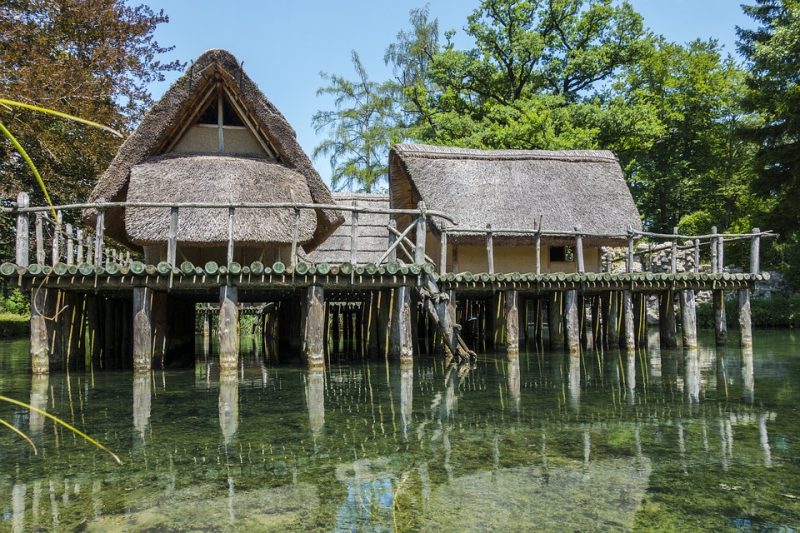Summary
– House on stilts: utility
– Characteristics of houses on stilts
– House on stilts: regulations and building permits
The house on stilts is suitable for sloping buildings and makes the happiness of those who want an atypical house, even a luxury hotel on a lagoon. The trend towards self-built wood-frame homes further democratizes stilt house construction and facilitates its study and realization.
Do you want to know more? What are the characteristics, advantages, and disadvantages of the house on stilts? Which authorization and which building permits are necessary to build it? This post answers all your questions.
House on stilts: utility
Since prehistoric times, the stilt house was known and had many advantages, whether to isolate oneself from the water or animals on the ground. If you don’t risk being eaten by a bear in your sleep nowadays, the house on stilts is still popular!
The stilt house is a simple and inexpensive construction that consists of raising the house’s low floor above the level of the ground.
The pilings are piles or posts driven into the ground that serve as a base for the construction and replace the foundations dug into the ground. Easier to build, pilings do not require soil excavation, reinforcement, drainage, or concrete pouring.
The main reasons for building on stilts are:
– construction on water (lagoon, lake, river, swamp, etc.) is the case for many lake villages and flood-prone sites. The pilings allow the floor of the house to be raised above the usual or accidental water level;
– construction on the flexible ground: in particular for works of art and heavy infrastructures for which pilings ensure a deep anchorage in the consistent part of the subsoil, thus avoiding the sinking of the structure;
– isolation from pests: living high up allows you to escape from animals on the ground, whether they are wild animals, snakes or insects that are dangerous to humans, or rodents that attack your food reserves;
– structural or aesthetic elevation: to succeed in building on a slope without having to remove the ground while creating a usable space at a lower cost (workshop, garage, shed, woodshed…) and ensuring the elevation of a house to obtain an enhancing view.
Advantages and disadvantages of stilt houses compared to slab houses.

Advantages of slab houses
– Common construction for any company;
– Possibility of elevation on crawl space participating in the insulation;
– All accesses on the same level are possible.
Disadvantages
– Implantation is sometimes impossible according to the nature of the ground;
– Leveling, earthwork, and foundations are essential;
– Inaccessibility of buried networks.
Advantages of a house on stilts
Affordable in self-construction;
– Can be built on any soil;
– No need to use grading, earthwork, or digging foundations;
– Easier and less expensive to build on high ground
– Freeing up space under the house that can be fully used and accessibility of networks;
– Security of the property (floods, threats to the ground).
Disadvantages of a house on stilts
– Reduced or difficult access on the same level;
– Requires additional insulation on the lower floor.
Characteristics of stilt houses
There are 3 techniques for building a house on stilts, which depend on the nature of the soil on which you will raise the construction:
1. Wooden stilts: wood is always topical to build a house on stilts, both on hard ground and soft ground, including water. The advantage of the wooden pile is that you can drive it into the ground with a minimum of digging, coring, or excavation. The wood is durable provided that it receives the necessary treatments for its good conservation in a humid environment and contact with the ground. The wooden pile is particularly adapted to self-construction or the construction of wooden or timber-frame houses.
2. Steel pilings: steel is denser and more robust than wood and just as durable if it has received the appropriate treatments. The construction on steel piles is comparable in technique with the structure on wooden piles with the advantage for steel supporting the sinking by powerful hammering and without damage. The steel pile allows more easily to consider a construction floor on the concrete screed.
3. Concrete pilings: this is the standard technique for traditional houses built on a slope to make up for the slope. Unless the pilings are made of cinder blocks with reinforcement and concrete pouring, it is necessary to consider more important formwork and vibrated concrete pouring to obtain a homogeneous and resistant structure.
Good to know: The technology of screwed foundations is a practical implementation of the house on stilts. Technical piles are screwed into the ground thanks to their specific head and the use of an installation machine.
Pile houses: regulations and building permits
The legislation does not significantly differ between traditional construction on poured foundations and structure on piles.
Although the land occupation is reduced for the house on stilts, it is the footprint (projected floor area) that determines whether or not a building permit or a simple declaration of work is required, depending on the local urban plan of the municipality:
When there is a local urban plan on the commune, the declaration of works alone is sufficient if the house on stilts is less than 12 m high and its footprint is less than 40 m² in a constructible zone and out of a great heritage site.
When there is no local urban plan on the commune, the declaration of works alone is sufficient if the footprint is less than 20 m² for less than 12 m height, in a constructible zone, and outside of an outstanding or protected heritage site.
A building permit is required beyond 20 m² or 40 m² of footprint depending on the case and above 12 m of ridge height.
Good to know: it is always possible to apply for a building permit or file a declaration of works before buying the land you want to build your house on stilts.